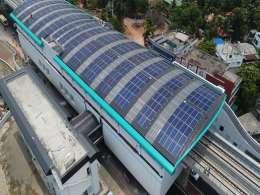China's factory sector shrank in November in the face of weakening demand both at home and abroad, two surveys showed on Thursday, underlining the central bank's move to cut bank reserve requirements to shore up the economy.
The official and HSBC purchasing managers' indexes are likely to feed worries that the global economy is on a slippery slope as the euro zone is marred by its debt crisis, reinforcing expectations that China will ease policy further.
The official PMI released by the China Federation of Logistics and Purchasing fell to 49 in November from October's 50.4, suggesting activity among big manufacturers shrank in November for the first time in nearly three years, or since the global financial crisis.
The reading was below the median forecast of 50 in a Reuters poll. That level demarcates expansion from contraction. The PMI has been around 50-51 since June.
"The November PMI dropped further to below the boom-bust line of 50... indicates that the economic growth pace would continue to moderate in the future," Zhang Liqun, a researcher with the Development Research Centre of the State Council, wrote in the CFLP statement.
The CFLP said the sub-index for new orders fell to 47.8 in November from 50.5 in October, while the sub-index for new export orders dipped to 45.6 in November from October's 48.6. Both sets of figures suggest the domestic and overseas new order books are shrinking.
Meanwhile, the HSBC China PMI dropped to a 32-month low of 47.7 in November from October's 51. A sub-index for new orders skidded to a 32-month low of 45 from 52.6 in October.
"The November PMI final reading points to a sharp deterioration in business conditions across the Chinese manufacturing sector," said Qu Hongbin, China economist at HSBC.
In one bright sign though, new export orders in the HSBC survey, geared more to smaller and private-sector factories, was comfortably above 50, suggesting growth.
China's economic expansion has been slowing all this year as Europe and the United States -- China's top two export markets -- have struggled to recover from the global financial crisis in 2008-2009.
In addition to global headwinds, China's once red-hot real estate sector is slowing down as home prices and sales fall.
China's central bank cut the reserve requirement ratio for its commercial lenders on Wednesday for the first time in nearly three years to ease credit strains and shore up an economy running at its weakest pace since 2009.
The reserve cut, effective Dec 5, reduces the ratio for the biggest banks to 21 per cent from a record high 21.5 per cent, freeing up funds that could be used for lending to cash-strapped small firms. Analysts said they expect further cuts in bank reserves.
Falling Inflation
The positive side of the surveys was that inflationary pressures in China could ease further, creating more room for the central bank to relax policy to support growth.
"We can see that the central bank is actually increasing the magnitude of policy easing, although it is still early to call it a comprehensive loosening," said Zhang Zhiwei, chief China economist at Nomura.
The prices sub-index of the official PMI fell to 44.4 from October's 46.2.
China's annual consumer inflation dipped to 5.5 per cent in October from September's 6.1 per cent, pulling back further from July's three-year peak of 6.5 per cent.
The National Development and Reform Commission, the country's top economic planning agency, forecast that inflation will fall below 5 per cent before the end of this year as food price pressures ease, the Economic Daily reported on Nov 14.
The HSBC PMI for November came in lower than its flash number released late in November and based on 90 per cent of responses.
Then flash reading of 48 implied annual industrial output growth of 11-12 per cent, HSBC said, a pace not seen since 2009 when China was pulling out of the global crisis.
Factory output, which accounts for 40 per cent of gross domestic product, hit its weakest pace in a year in October, even though expansion in the first 10 months of 2011 averaged 14.1 per cent.





